Your donation will support the student journalists of Carmel High School - IN. Your contribution will allow us to purchase equipment and cover our annual website hosting costs.
With additional COVID-19 regulations, staff members find themselves working harder during school hours
September 25, 2020
Before COVID-19 shut this school down in March, French teacher Lisa Carroll already had her lessons planned out for the upcoming year. She knew she could use materials from past years to help her teach concepts to students intent on learning.
However, with the new challenges in this school year, Carroll said she can no longer rely on past materials; instead, she said she needs to create short videos for virtual learners as well as update her Canvas structure with modified lessons. Because of all these changes, she said she is doing more work than ever in the past.
According to Carroll, many teachers are feeling overwhelmed because of the new routine and structure.
“In March, when we went fully online, it was a huge upheaval on how I conduct everyday lessons and classes,” she said. “Also, only seeing my students once a week instead of two or three times has been a big difference on how I teach.”
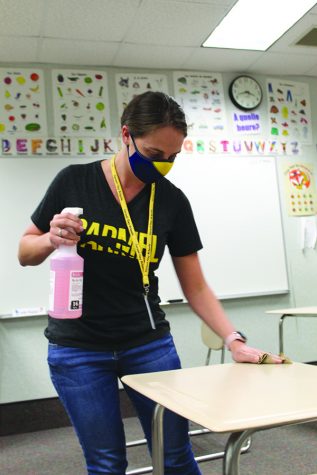
“The main challenge for teachers now is creating the online materials. Many teachers I talk to have said, ‘I feel like a first-year teacher again,’ so it feels like we are starting over again,” she added. “This has added a whole new plate of planning and prep work, plus a little bit of stress.”
Social studies teacher Sandy Gardner had a similar sentiment. She said, “Teachers are definitely working harder, even harder than the spring. We are doing virtual work and in-class work so it is double (the amount of work).”
Sophomore Cate Beck, whose father Peter Beck teaches mathematics at CHS, said she does not see her father as often because of his extra virtual work.
“His schedule is always full between helping around the house and driving us kids around to activities when he’s not in a (Zoom) call,” she said.
Because of the added work pressures on Mr. Beck, Cate said she helps support her father by helping with her younger siblings.
“I have been helping by watching my younger siblings so that my dad can get his work done and not be interrupted during (Zoom) calls,” she said.
In late July, a national poll from NPR/Ipsos found that 66% of teachers preferred a virtual learning environment rather than an in-person or hybrid one.
Carroll said there have been some mixed opinions from CHS teachers on opening school. Furthermore, she said the staff has become more aware of the potential risks associated with not following the guidelines properly.
“I feel like teachers in general are doing a good job with maintaining the guidelines sent to us about keeping students safe, but there are some teachers who are more concerned due to underlying conditions than others,” Carroll said. “However, I feel that all teachers are aware that our actions affect more people than just us. Because of that, I am much more cautious in my personal life knowing that I’m exposed to over 120 students each week.”
However, the pandemic has not only impacted the learning environment. Lori Vohs, assistant food service manager at Greyhound Station, said there has also been a substantial increase in her workload because of the changes to protocol. Specifically, she said the cafeteria staff now individually bags and wraps all of the food they prepare.
“I don’t know if (the administration) really realizes how much work it is to bag the food,” Vohs said. “I think (the administrators) know what’s going on, but some days you’re just like, ‘Ugh.’ It is a lot of work, and I don’t know if (people) realize sometimes how much work it actually is, to remember what’s in what bag, to make sure everything’s labeled, that sort of thing.”
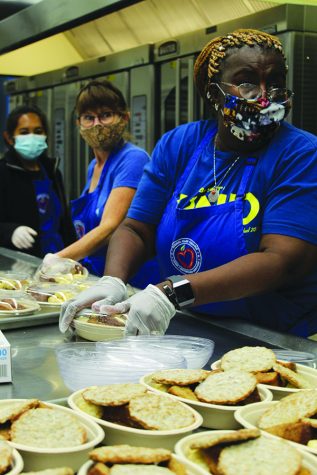
Vohs also said there are difficulties in keeping up with the workload because there are fewer cafeteria staff members this year.
“(My staff) shrank down because they took people out of my kitchen and they have moved them to elementary schools,” she said. “I work a line every day—I’m out there completely—and there’s just no time. And when the kids come, they come fast, and they want their food, and you’re like, ‘Ahh!’”
In regard to students, Vohs said while students have been actively socially distancing to the best of their ability, it has still been difficult to enforce the rule in lunch lines.
“Even on the first day, (with) the (hand) sanitizer, you can try your best to get them to use it, but it’s just not (working),” she said. “The social distancing in the line is hard to manage. They do good out here, as far as sitting at the tables (socially distanced), but in the lines they just bunch up. They want to be together.”
However, both Vohs and Greyhound Station chef Karen Courter said they agreed students have been very vigilant in regard to wearing masks properly.
“I’m really happy how people are embracing the masks,” Courter said, referring to the recent trends displayed with masks. “It doesn’t bother a lot of people, and we just want to be back to normal and help the kids feel as comfortable as we can make them be.”
In general, Vohs said the overall protocol for cafeteria staff is not entirely new.
“Really as far as what we do, (the protocol) has not really changed,” she said. “We always wash our hands, wear our gloves, wear our aprons (and) we change the aprons. The only thing different is the mask, which sometimes gets difficult when it’s hot, but I think overall we’ve always been (using similar protocol).
“I think that the major issue is trying to make sure everything’s in a bag,” Vohs added. “It’s less kids, but because you have to do that, it feels like a lot more work.”
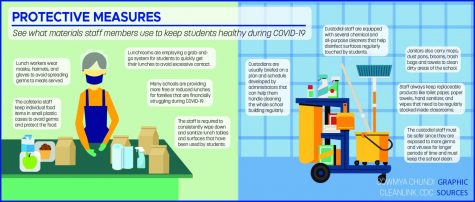
Similarly, the custodial staff has had a general increase in workload since this school shut down in March. According to custodial supervisor Bob Hargis, custodians have had more cleaning requirements added on to their previous routine compared to past years.
Hargis said the custodial staff normally would clean the whole building every summer by wiping down walls and replacing broken or damaged parts of classrooms. He added they did all of these procedures this summer, but the staff also had additional regulations to follow when cleaning and repairing.
“We do all of that every summer, but in addition to that, this year we were using sterilizing equipment and sterilized everything inside every classroom,” Hargis said. “So it definitely added some work to our summer work. We also had to work around the construction that was happening.”
According to Hargis, another important change to the custodial staff was the addition of two new cafeterias, namely the media center and upper deck of the varsity gym. He said the custodians are assigned to each cafeteria; in the past, the custodians could “float around” and help one another. Because of this, according to Hargis, many situations regarding problems around the school, unless urgent, are being pushed later to fix.
He said, “When a work order comes in, such as a teacher spilled something or a light switch is broken, we don’t have people to send to fix those problems, so it’s created a real challenge for us to keep the routine. If it’s not an emergency, we just do those work orders in the mornings, which has been helped by the later start times.”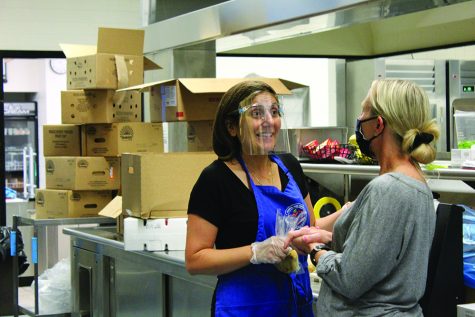
Outside of school, Cate Beck said she and her family cannot do as many activities as they did before the pandemic because of the changes they have had to make to their routines due to her father’s work schedule.
“Because my dad has to work more and I have to help him more, we have less time to just relax and be able to spend time together like we were able to before COVID-19,” she said.
Gardner said the new changes have impacted how much time she has to spend with her family.
“We are careful, but we still live our lives by going (to) places as a family,” she said. “In terms of work, teaching has its own demands right now, but added to that is leaving two kids at home to do their virtual work. Sometimes it is difficult because when I get home from work, I have to help with the work that my kids have questions on.”
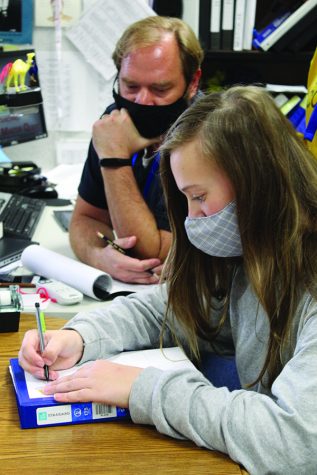
Carroll said the new schedule has blended some aspects of her work time and her personal time.
“Personally, I don’t take my work home with me after the school day is done, but because of the extra work, I have to stay at school for longer hours,” she said. “Plus, I have my emails sent to my phone, so sometimes I get emails from teachers or students at home and I need to respond to them, so it feels like I am (at work) all the time.”
Gardner also said the new procedures have some consequences in terms of increasing the amount of student participation while in class with new peers and teachers.
“I want students to be more willing to talk to a new person, even with a mask on,” she said. “Being in group work usually assists in getting students to know each other. The issue is trying to do that with social distancing.”
Carroll said she agreed with Gardner about the obstacles with new routines at school and added she finds the new procedures hinder students from learning and communicating the same teachers and mentors compared to previous years.
“With language learning, we have seen through research that the best way for students to learn it is through constant exposure and hearing it often,” Caroll said. “Added to that, SSRT is another challenge because (it is) only one session. Now, if my students need help or have trouble, they can only see me once a week for that, and if they have a pass for a different teacher, then it might be two weeks before they get their questions answered.”
With the new circumstances imposed by the pandemic, the staff also said they have felt more gratitude and appreciation from the student body as a whole.
“Personally, I think gratitude is always appreciated, no matter what or why,” Carroll said. “I actually had my students email all their teachers on the first day saying
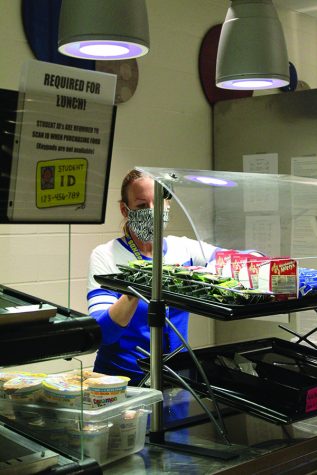
how much they appreciate their teachers’ hard work. It’s always nice when I see students who are flexible and patient whenever something happens because it’s almost like (us teachers) are reinventing the wheel.”
Vohs said she thinks the loss of social interaction between the students due to quarantine has been a factor in changing students’ perspectives on attending school.
“I think we’re trying harder this year to say hi to the kids, try to get into the world, try to talk to them more, say, ‘How’s your day going?’ say, ‘Have a good day,’” Vohs said. “I think they’re just happy to be here. I think the kids understand. They’re more grateful this year.”
